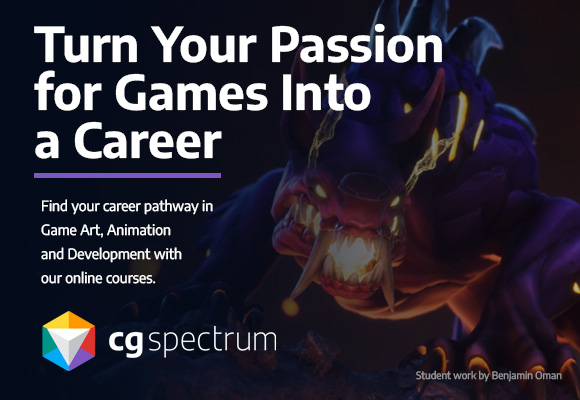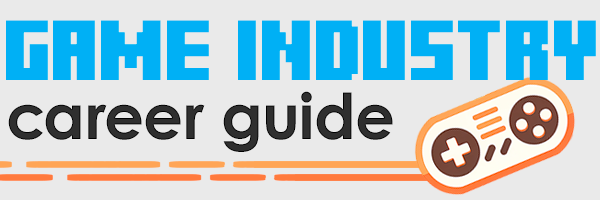The Pros (And Cons) of an Art Degree for Video Games

Branden Brushett is a professional 3D artist in the video game industry, with credits on hit games like Minecraft, MetalStorm, and Paradise Bay. But it took more than an art education to break into the game industry. After art school, Branden’s journey had only just begun. Success as a game artist demanded serious effort, countless hours, and literally chasing his dream across the country.
We’re speaking with Branden today to learn why you should (or shouldn’t!) get an art degree, how to choose and apply to art schools, and how you might be able to score a free education and follow a non-standard path into the game industry.

Is art school the best way to break into the game industry?
The short answer? No. If you would have asked me if art school was the best path 10 years ago, I would have said yes. But since then, things have changed significantly thanks to websites like YouTube, Gnomon, 3dtotal, Udemy and Lynda, just to name a few. These sources did not exist when I went to school. Since aspiring artists now have significantly more schools to choose from, the answer really is: it depends on the artist.
Back in 2006, I enrolled in a one-year Game Art and Design program at Vancouver Institute of Media Arts in Vancouver, Canada. For me, I excel in a classroom setting and I enjoy being part of a team. I find it more beneficial to have an instructor directly in front of me answering questions and helping me problem solve the complicated world of game art.
As a bonus, in a school setting you won’t only learn from the teacher but from your fellow art students as well. That’s similar to a game studio setting, because we are always learning something new when making games as a team.
So an art degree isn’t required in games?
Absolutely not. You can learn so much through online tutorials and just dedicating the time at home to perfect your craft.
There were only a handful of art schools back in my day. Oh man, I sound so old when I say that. But thinking back, I really had no idea what I was signing up for. All I knew was that a career handling timeshare real estate contracts was not going to be a fulfilling life for me.
But one thing is very clear from my experience: whether you decide to attend a school or not, you have to want it. Badly. Because the road to working in the game industry can be a long one.
What’s a good way to choose the right art school?
Knowing what I know now about game art schools, this is what I would look out for:
- Instructors: The instructors at the school should have first-hand knowledge of the game industry. They should have “been there, done that” and can share their experience with you about their time working in a professional studio. Whether their experience was at a game, film, or animation studio, they should prepare you for what the art pipeline looks like, and train you to hit the ground running once you get hired.
- Classes: You will need to learn the most modern software programs that game studios use nowadays. It’s not just Maya, Photoshop and a little bit of ZBrush anymore. Take a look at game studio job descriptions, most will list the three programs I just mentioned along with Substance Designer, Painter, 3D Coat and game engines like Unity and Unreal. If you don’t see any of those tools listed in the course descriptions, then find another school that does.
- Cost and time: How much can your afford? One year at $40k? Two years at $80k? You need to think long term and have a plan to pay back those loans. As nice as some of the schools sales pitches sound, with their “90% of graduates get hired after school” story, chances are you will not get hired right away. That’s just a reality. There are not enough jobs in the industry to hire us all. So be wary of the sales pitch, and if they’re trying to sell you hard like an aggressive car salesman, then you should probably run like I did. (Rest in peace, Art Institute!)
Do you have any tips for artists applying to art school?
This is where those free or inexpensive online tutorials come into play. If you are interested in applying to an art school, most, if not all schools require a portfolio. The art I sent in, looking back now, was horrible. I couldn’t even submit it through email back then. I actually mailed in art I drew on paper with colored pencils. So don’t worry about making it look as if you already work in a game studio.
Schools want to know if you have the potential to be a great artist. Can you be taught? Drawing like a pro is not a talent that’s gifted to you when you are born. Drawing is a skill you can learn. You do not have to spend thousands of dollars on a 3D modeling program like Maya in order to learn 3D modeling. You do not need a thousand dollar Wacom Cintiq with Photoshop to learn how to paint like a pro.
Drawing like a pro is not a talent that’s gifted to you when you are born. Drawing is a skill you can learn.
Look for free programs like Blender to start learning how to 3D model. iPad Pros and other portable devices that you can draw on, along with affordable programs like Procreate and SketchBook Pro, are excellent ways to prepare yourself. And you might as well start now if you haven’t already. Draw, draw, draw. You will be doing a lot of it in school.
Can an artist get a job, even if they can’t afford art school?
Yes. Let me say that again: Yes!
I have worked at three different game studios now, and not once has anyone asked where I went to school or if I had a bachelor’s degree.
Where you went to school or if you even went to school never really mattered. The only thing that matters is your portfolio. Can you create high quality art the studio needs in a timely manner? That’s all they really want.
One very important side note to keep in mind: During the interview process, they will also be deciding whether they think you are a good fit for the team. You can be the greatest artist in the world, but if you bring a negative attitude or act like you know everything — or worse, act like you know more than those interviewing you — you won’t get the job. And yes, I have seen many great artists, much more skilled than me, come and go based on their attitude alone.
Long story short, if you have an awesome portfolio and you’re not a jerk, you’re well on your way to a successful game art career.
What resources do you recommend for learning game art?
I have mentioned a few websites to learn game art from already, but you should start with YouTube. Because, well, free is nice, right? I mean, if YouTube can teach me how to remodel my bathroom, do electrical work, and install a kitchen sink, then it can teach you pretty much anything. How I’m still alive after many DIY projects is beyond me but it just goes to show, you can learn a lot on YouTube!
Knowing what I know now, I would start with YouTube and dedicate a significant amount of time trying to learn on my own — saving thousands of dollars in the process — before committing to an art school.
Also, look into Blender. Blender was around back in my day as well, but it was kind of a joke. Our class learned a few things just to check it out and compare it to Maya, which was far superior, but now it is a serious competitor to what Autodesk has to offer. In fact, for the first time in 13 years of looking at job descriptions, I saw one specifically asking for Blender experience. Mind. Blown. Plus, it’s free to download. So try it out!
What advice can you offer to artists struggling to land their first game job?
If you’re struggling to land your first job in the industry, then welcome to the club. That’s part of the journey. When I first started to apply to game studios, I must have received the “thanks, but no thanks” email hundreds of times. You are trying to join an industry that is notoriously difficult to get a job in.
I will share with you my struggle.
After finishing school in Canada, I moved back to Southern California where I am originally from and started my search in Orange County and San Diego. Surprisingly, I quickly got an interview with Rockstar San Diego. I interviewed there and got to see a sneak peak of a buggy little game set in the old west that you have probably never heard of. What was it? Red Dead something? I guess it’s like, really popular now or something. Anyway, I went to lunch with the team, and I thought for sure I was going to get hired.
Why did I think that? Because as I left the interview, I was specifically told “I don’t see a reason why we wouldn’t hire you.” Seemed like a pretty clear indication that I nailed it.
I waited weeks and weeks, and didn’t hear anything from them. Each time my phone rang I nearly had a heart attack. “This is it! It’s happening… Oh, hi mom.” I finally reached out to one of the artists I interviewed with and found out they decided to hire a different artist with more experience.
Needless to say, I was devastated. That was the only real chance I had in So Cal other than a couple of art tests that went nowhere. For three years, every studio I applied to said Thanks, but no thanks.
That sounds heartbreaking. How did you finally get a job?
I believe there is one specific decision I made that allowed my dream to come true, and this may be key to your success as well: I had to move. Move out of my comfort zone in Southern California and move right into a gaming epicenter.
I moved to Seattle, and in four months I got a job as a quality assurance tester at Microsoft, working on Gears of War 3. And nine months after that, I got hired into my first 3D environment art role at a local third-party game development studio, working on the Shinobi franchise. In my eyes, I. Had. Made. It.
So if you live in a town that has zero game studios and you’re applying to studios thousands of miles away, it’s very difficult for them to hire you, because many studios prefer applicants to be local. It’s just easier and quicker to bring you in for an interview. So whether it’s Seattle, San Francisco, Los Angeles, Austin, or even up in Canada like Vancouver, Toronto or Montreal, consider a change of pace and make the move. Even if it’s only temporary.
Think about it: If you want to be a famous actor, what do you do? Stay in Montana? No, you move to Hollywood. That’s where you go to be an actor. So get to know the cities that have a bunch of game studios and don’t be shy when you get there. Make new friends and network with those that can help you achieve your dream.
How can new graduates compete with experienced artists for jobs?
I don’t think it matters that much really. In fact, in some cases, you may have an advantage. It’s all in how you approach the situation and how you sell yourself.
I successfully tackled this exact scenario in a job interview, by explaining how hiring me, a rookie way in over his head, was the better choice. I explained that I am much better than an experienced and quite possibly jaded artist who is already set in their ways. I, on the other hand, am still learning and growing and you can mold me into being the artist you need me to be. I will be able to create art the way this studio creates it. And it worked.
Any other advice for getting into the game industry as an artist?
Everyone’s path into the game industry is going to be different. If you want to attend an art school, then go for it. Don’t let anyone stop you. I certainly do not regret going to an art school. I might not have learned everything I needed — I definitely had to learn a lot on my own — but the life experience I gained in the process is indispensable.
If you are dying to get out of your parents’ house and follow your dream, there really is no better experience than moving out on your own, expanding your knowledge, and gaining priceless memories you will look back on for years to come.
But let me make this clear: You have to want it. There is a very good chance you will be struggling for years after school, before you get your first break. To increase your chances, embrace the fact that you may need to start from the bottom.
I, like so many others, started as a QA tester. And honestly, it’s a great way to get started. Being a QA tester will give you a behind-the-scenes look at how a studio makes a game from prototype to launch. All while you keep working on your portfolio at night, and networking with industry vets and fellow artists at local meet ups and conventions. Remember, who you know in this industry is just as important as what you know.
Whatever path you choose, keep moving forward. Do not give up. Working in the game industry is worth the struggle. Find a path that works best for you or, better yet, blaze a path of your own.
Branden Brushett is a professional 3D artist in the video game industry. Connect with him on LinkedIn, or check out his online art portfolio at www.brandenbrushett.com.
Read my new book!
Making games for a living is an incredibly rewarding career, but it’s hard to break in unless you have insider knowledge. This book levels the playing field.


Leave a Reply